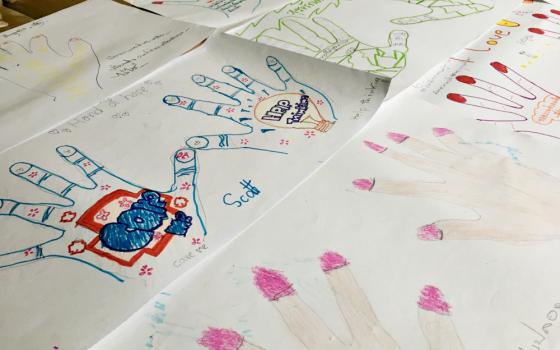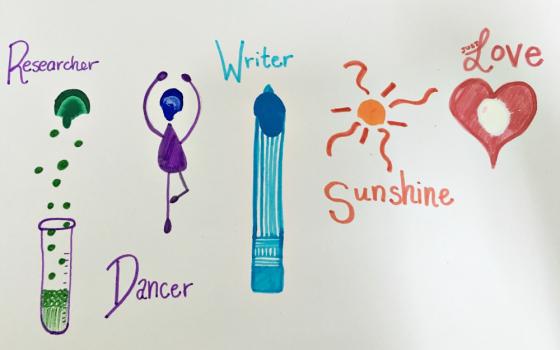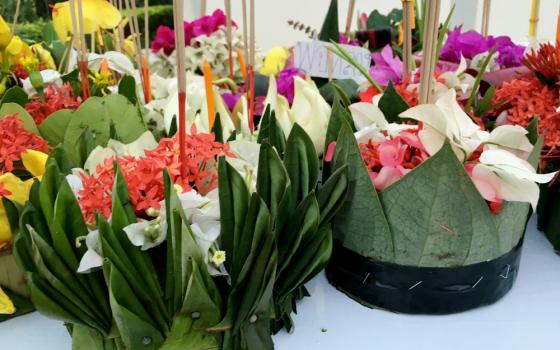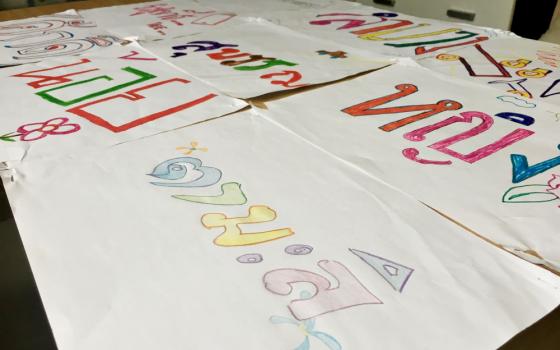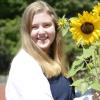Notes from the Field includes reports from young people volunteering in ministries of Catholic sisters. A partnership with Catholic Volunteer Network, the project began in the summer of 2015. This is our fifth round of bloggers: Katie Delaney is a Good Shepherd Volunteer with the Fundación Madre Josefa (Mother Joseph Foundation) in Santiago, Chile, and Lauren Magee is a Good Shepherd Volunteer at Hands of Hope, an income-generating project that provides dignified employment for villagers living with HIV/AIDS in Nong Khai, Thailand.
______
"I feel there is nothing more artistic than loving people." —Vincent Van Gogh
Both of my volunteer years have proven to me that I thrive in a work environment that fosters creativity.
Currently, I serve at Hands of Hope, an income-generating project that has produced 599 designs, including cards, notebooks, decorative wall hangings, and earrings, since its founding in 2005. We have a group of 35 producers that handcraft each and every product, and I enjoy when I get to step away from the computer and join them in the production process.
I contributed to our annual design workshop in December and have been challenged to handcraft more than 50 notebooks for a variety of customers. Creativity can be expressed in many different ways, but for me, the tactile nature of our work is therapeutic and allows me the space to think more clearly.
Before I arrived in Nong Khai, I had heard that one of the sisters led a weekly art therapy session with the patients at the Care and Life Centers. Even though I knew I was going to be surrounded by art at Hands of Hope, I was eager to participate in the sister's lessons and became involved almost immediately after I arrived. As the sister's schedule become more and more overloaded with tasks and meetings, I began to take on more responsibility and facilitate the art sessions myself.
Americans pride themselves on their confidence, individuality and self-identity. Young Americans are often raised to believe that they are special, unique, that they have the ability to make anything happen. I've carried these beliefs with me throughout my life, and I often expect the same of others. Many of the art therapy exercises I was exposed to in the United States centered around self-awareness and building a greater understanding of self, so I prepared my first lesson on just that. I wanted to challenge the patients to define themselves, and the results were surprising.
The prompt was to place five fingerprints on a piece of paper and turn them into five drawings that described you. It seemed simple enough, and I even displayed my own example, but the only response I got was confusion.
I had one of the staff members assist me with my Thai, and slowly but surely, the patients began to pick up their markers and create. Many combined their fingerprints into one drawing of natural scenery, and I asked each of them to explain what they had made.
They said what defined them were the trees, the water, and maybe a small shelter among the fields. Some patients even drew the Care Center to represent that they were a product of their home. I have always strived to maintain my individuality, but the patients simply wanted to belong to the Earth.
In general, decisions in Thai culture are made by a whole community rather than by one individual. People tend to share their personal burdens and successes and take on those of their close family and friends, as well. I was seeing in this activity that it was impossible for some of the patients to think about their existence without the presence of others.
A few weeks later, I focused on goal visualization and instructed them to illustrate their biggest dream with paint. I thought some would dream of wealth or fame, but most painted modest houses set in rice fields. They didn't want luxuries. They just wanted their own land and the freedom to maintain it.
In our Western consumer-driven culture, we are constantly striving for more. If your happiness is reliant on materialistic success, you may live life forever disappointed. However, if you are content with just the necessities, every day brings happiness.
Although our dreams differ, we were all joined in an activity in another art therapy session that called us to write or visibly represent our burdens on rocks so we could then throw them into the small lake on our property. I was inspired by the Loi Krathong festival, which is celebrated every November. People purchase or make decorative krathong out of banana leaves and flowers to send into the river to both purify themselves and express their gratitude toward nature.
I didn't ask the patients to share their burdens, and I didn't share my own, but we all supported each other mentally and physically as we made the short walk to the lake and rid ourselves of the rocks — the burdens — that had been weighing us down.
It can be difficult to ask for help carrying our burdens because we don't want to weigh anyone down or prevent them from managing their own burdens. Additionally, we can feel restricted by our burdens to the point where we don't realize the strength we are capable of.
In another art therapy exercise, we outlined both of our hands on a piece of paper. The first represented the ways we could help others, and the second, ways others could help us. My goal was to empower the patients who felt weak and encourage them to contribute in small ways. We discussed that helping others could be done with a smile or a compliment. Actions don't have to be grand to make a difference.
This activity also allowed us to share what we needed from our community. I requested patience, especially in conversation, because I would get easily flustered when trying to both speak and understand Thai.
Art therapy has become my favorite way to bond with the patients because we can connect without the pressures of language. I hear them in a new way when they speak through their art, and it allows me to see nuances in their personalities that would otherwise go unnoticed. It's a time for us to connect through our shared experience and to broaden our understanding of our differences. We aren't creating artistic perfection. We are creating a relationship, which is a masterpiece in itself.
[Lauren Magee is a Good Shepherd Volunteer at Hands of Hope, an income-generating project that provides dignified employment for villagers living with HIV/AIDS in Nong Khai, Thailand.]
